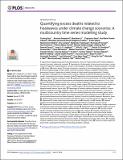Por favor, use este identificador para citar o enlazar a este item:
http://hdl.handle.net/10261/173836COMPARTIR / EXPORTAR:
 SHARE SHARE
 CORE
BASE CORE
BASE
|
|
| Visualizar otros formatos: MARC | Dublin Core | RDF | ORE | MODS | METS | DIDL | DATACITE | |

| Campo DC | Valor | Lengua/Idioma |
|---|---|---|
| dc.contributor.author | Guo, Yuming | es_ES |
| dc.contributor.author | Tobías, Aurelio | es_ES |
| dc.contributor.author | Tong, Shilu | es_ES |
| dc.date.accessioned | 2019-01-09T11:56:33Z | - |
| dc.date.available | 2019-01-09T11:56:33Z | - |
| dc.date.issued | 2018-07 | - |
| dc.identifier.citation | PLoS Medicine 15 (7): e1002629 (2018) | es_ES |
| dc.identifier.uri | http://hdl.handle.net/10261/173836 | - |
| dc.description.abstract | Background: Heatwaves are a critical public health problem. There will be an increase in the frequency and severity of heatwaves under changing climate. However, evidence about the impacts of climate change on heatwave-related mortality at a global scale is limited. Methods and findings: We collected historical daily time series of mean temperature and mortality for all causes or nonexternal causes, in periods ranging from January 1, 1984, to December 31, 2015, in 412 communities within 20 countries/regions. We estimated heatwave–mortality associations through a two-stage time series design. Current and future daily mean temperature series were projected under four scenarios of greenhouse gas emissions from 1971–2099, with five general circulation models. We projected excess mortality in relation to heatwaves in the future under each scenario of greenhouse gas emissions, with two assumptions for adaptation (no adaptation and hypothetical adaptation) and three scenarios of population change (high variant, median variant, and low variant). Results show that, if there is no adaptation, heatwave-related excess mortality is expected to increase the most in tropical and subtropical countries/regions (close to the equator), while European countries and the United States will have smaller percent increases in heatwave-related excess mortality. The higher the population variant and the greenhouse gas emissions, the higher the increase of heatwave-related excess mortality in the future. The changes in 2031–2080 compared with 1971–2020 range from approximately 2,000% in Colombia to 150% in Moldova under the highest emission scenario and high-variant population scenario, without any adaptation. If we considered hypothetical adaptation to future climate, under high-variant population scenario and all scenarios of greenhouse gas emissions, the heatwave-related excess mortality is expected to still increase across all the countries/regions except Moldova and Japan. However, the increase would be much smaller than the no adaptation scenario. The simple assumptions with respect to adaptation as follows: no adaptation and hypothetical adaptation results in some uncertainties of projections. Conclusions: This study provides a comprehensive characterisation of future heatwave-related excess mortality across various regions and under alternative scenarios of greenhouse gas emissions, different assumptions of adaptation, and different scenarios of population change. The projections can help decision makers in planning adaptation and mitigation strategies for climate change. © 2018 Guo et al. http://creativecommons.org/licenses/by/4.0/. | es_ES |
| dc.description.sponsorship | We thank relevant institutes/agencies who provided data on mortality and weather conditions. | es_ES |
| dc.language.iso | eng | es_ES |
| dc.publisher | Public Library of Science | es_ES |
| dc.relation.isversionof | Publisher's version | es_ES |
| dc.rights | openAccess | es_ES |
| dc.subject | Hot temperature | es_ES |
| dc.subject | Temperatures | es_ES |
| dc.subject | Heat-related mortality | es_ES |
| dc.title | Quantifying excess deaths related to heatwaves under climate change scenarios: A multicountry time series modelling study | es_ES |
| dc.type | artículo | es_ES |
| dc.identifier.doi | 10.1371/journal.pmed.1002629 | - |
| dc.description.peerreviewed | Peer reviewed | es_ES |
| dc.relation.publisherversion | https://doi.org/10.1371/journal.pmed.1002629 | es_ES |
| dc.relation.csic | Sí | es_ES |
| oprm.item.hasRevision | no ko 0 false | * |
| dc.identifier.pmid | 30063714 | - |
| dc.type.coar | http://purl.org/coar/resource_type/c_6501 | es_ES |
| item.cerifentitytype | Publications | - |
| item.openairecristype | http://purl.org/coar/resource_type/c_18cf | - |
| item.grantfulltext | open | - |
| item.openairetype | artículo | - |
| item.fulltext | With Fulltext | - |
| item.languageiso639-1 | en | - |
| Aparece en las colecciones: | (IDAEA) Artículos | |
Ficheros en este ítem:
| Fichero | Descripción | Tamaño | Formato | |
|---|---|---|---|---|
| Quantifying excess deaths related to.pdf | 1,99 MB | Adobe PDF |  Visualizar/Abrir | |
| Appendix. Quantifying excess deaths related to heatwaves under climate.pdf | Data collection and supporting tables and figures | 1,83 MB | Adobe PDF |  Visualizar/Abrir |
CORE Recommender
PubMed Central
Citations
51
checked on 28-abr-2024
SCOPUSTM
Citations
236
checked on 29-abr-2024
WEB OF SCIENCETM
Citations
206
checked on 29-feb-2024
Page view(s)
221
checked on 01-may-2024
Download(s)
339
checked on 01-may-2024
Google ScholarTM
Check
Altmetric
Altmetric
Artículos relacionados:
NOTA: Los ítems de Digital.CSIC están protegidos por copyright, con todos los derechos reservados, a menos que se indique lo contrario.
